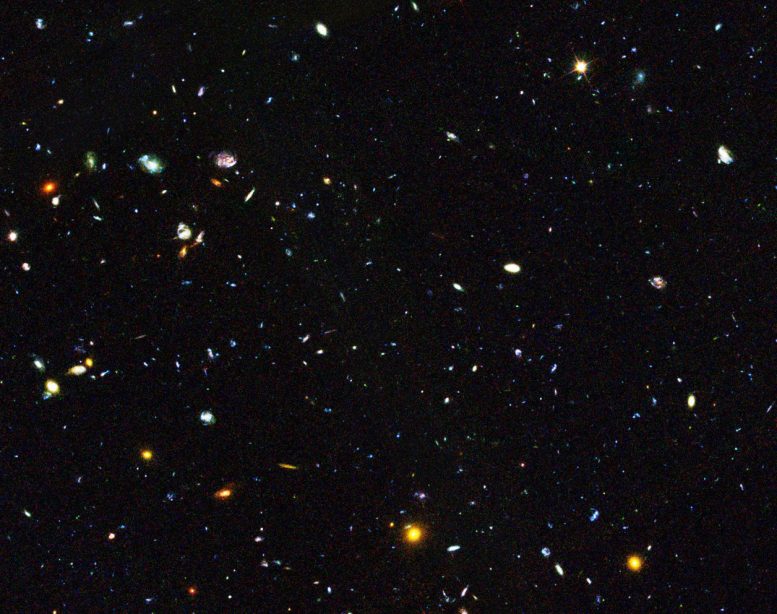
Hiding among these thousands of galaxies are faint dwarf galaxies residing in the early universe, between 2 and 6 billion years after the Big Bang, an important time period when most of the stars in the universe were formed. Some of these galaxies are undergoing starbursts. Credit: NASA and ESA
Using data from NASA’s Hubble Space Telescope, astronomers take a significant step forward in understanding how dwarf galaxies contributed to the star population in our universe.
They may be little, but they pack a big star-forming punch. New observations from NASA’s Hubble Space Telescope show small galaxies, also known as dwarf galaxies, are responsible for forming a large proportion of the universe’s stars.
Studying this early epoch of the universe’s history is critical to fully understanding how these stars formed and how galaxies grew and evolved 3.5 to 6 billion years after the beginning of the universe. The result supports a decade-long investigation into whether there is a link between a galaxy’s mass and its star-forming activity, and helps paint a consistent picture of events in the early universe.
“We already suspected these kinds of galaxies would contribute to the early wave of star formation, but this is the first time we’ve been able to measure the effect they actually had,” said Hakim Atek of the École Polytechnique Fédérale de Lausanne (EPFL) in Switzerland, lead author of the study published in the June 19 online issue of The Astrophysical Journal. “They appear to have had a surprisingly huge role to play.”
Previous studies of star-forming galaxies were restricted to the analysis of mid- or high-mass galaxies, leaving out the numerous dwarf galaxies that existed in this era of prolific star formation. Astronomers conducted a recent study using data from Hubble’s Wide Field Camera 3 (WFC3) to take a further and significant step forward in understanding this formative era by examining a sample of starburst galaxies in the young universe. Starburst galaxies form stars at a furiously fast rate, far above what is considered by experts to be a normal rate of star formation.
The infrared capabilities of WFC3 have allowed astronomers to finally calculate how much these low-mass dwarf galaxies contributed to the star population in our universe.
“These galaxies are forming stars so quickly they could actually double their entire mass of stars in only 150 million years – an incredibly short astronomical timescale,” adds co-author Jean-Paul Kneib, also of EPFL.
Researchers say such massive growth would take most “normal” galaxies 1 to 3 billion years.
In addition to adding new insight into how and where the stars in our universe formed, this latest finding may also help to unravel the secrets of galactic evolution. Galaxies evolve through a jumble of complex processes. As galaxies merge, they are consumed by newly-formed stars that feed on their combined gases, and exploding stars and supermassive black holes emit galactic material – a process that depletes the mass of a galaxy.
It is unusual to find a galaxy in a state of starburst, which suggests to researchers that starburst galaxies are the result of an unusual incident in the past, such as a violent merger.
Reference: “Hubble Space Telescope Grism Spectroscopy of Extreme Starbursts across Cosmic Time: The Role of Dwarf Galaxies in the Star Formation History of the Universe” by Hakim Atek, Jean-Paul Kneib, Camilla Pacifici, Matthew Malkan, Stephane Charlot, Janice Lee, Alejandro Bedregal, Andrew J. Bunker, James W. Colbert, Alan Dressler, Nimish Hathi, Matthew Lehnert, Crystal L. Martin, Patrick McCarthy, Marc Rafelski, Nathaniel Ross, Brian Siana and Harry I. Teplitz, 19 June 2014, The Astrophysical Journal.
DOI: 10.1088/0004-637X/789/2/96
arXiv: 1406.4132
The Hubble Space Telescope is a project of international cooperation between NASA and the European Space Agency. NASA’s Goddard Space Flight Center in Greenbelt, Maryland, manages the telescope. The Space Telescope Science Institute (STScI) in Baltimore conducts Hubble science operations. STScI is operated for NASA by the Association of Universities for Research in Astronomy, Inc., in Washington.









Be the first to comment on "Hubble Reveals the Role of Dwarf Galaxies in the Star Formation History of the Universe"